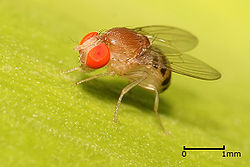Drosophilidae
| Drosophilidae | |
|---|---|

| |
| Drosophila sp. | |
| Scientific classification | |
| Kingdom: | |
| Phylum: | |
| Class: | |
| Order: | |
| Suborder: | |
| Section: | |
| Subsection: | |
| Superfamily: | |
| Family: | Drosophilidae Róndani, 1856
|
| Subfamily | |
The Drosophilidae are a diverse, cosmopolitan family of flies, which includes fruit flies. Another unrelated family of flies, Tephritidae, also includes species known as "fruit flies". The best known species of the Drosophilidae is Drosophila melanogaster, within the genus Drosophila, and this species is used extensively for studies concerning genetics, development, physiology, ecology and behaviour. This fruit fly is mostly composed of post-mitotic cells, has a very short lifespan, and shows gradual aging. As in other species, temperature influences the life history of the animal. Several genes have been identified that can be manipulated to extend the lifespan of these insects.
Economic significance
Generally, drosophilids are considered to be nuisance flies rather than pests, since most species breed in rotting material. Zaprionus indianus Gupta is unusual among Drosophilidae species in being a serious, primary pest of at least one commercial fruit, figs in Brazil.[1] Another species, Drosophila suzukii, infests thin-skinned fruit such as raspberries and cherries and can be a serious agricultural pest.[2] Drosophila repleta larvae inhabit drains and spread bacteria. Fruit flies in general are considered as a common vector in propagating acetic acid bacteria[3] in nature. This often ruins the alcohol fermentation process and can ruin beer or wine by turning it into vinegar.
Identification
The diagnostic characteristics for Drosophilidae include the presence of an incomplete subcostal vein, two breaks in the costal vein, a small anal cell in the wing, convergent postocellar bristles; and usually three frontal bristles on each side of the head, one directed forward and the other two directed rearward. More extensive identification characteristics can be found in "Drosophila: A Guide to Species Identification and Use" by Therese A. Markow and Patrick O'Grady, (Academic Press, 2005) ISBN 0-12-473052-3 or "Drosophila: A Laboratory Handbook" by M. Ashburner, K. Golic, S. Hawley, (Cold Spring Harbor Laboratory Press, 2005).
Anti-parasitic behavior
When the flies see female larval endoparasitoid wasps, they switch to laying their eggs in rotting fruit, which contains alcohol. Doing this protects the flies from becoming host to the larvae, as the wasps have a low alcohol tolerance.[4]
Phylogeny
The family contains more than 4,000 species classified under 75 genera. Recently, a comprehensive phylogenetic classification of the genera based on both molecular and morphological characters has been published.[5]
- Subfamily Drosophilinae Rondani, 1856:
- Tribe Colocasiomyini Okada, 1989:
- Genus Baeodrosophila Wheeler & Takada, 1964
- Genus Balara Bock, 1982
- Genus Chymomyza Czerny, 1903
- Genus Colocasiomyia de Meijere, 1914
- Genus Lissocephala Malloch, 1929
- Genus Neotanygastrella Duda, 1925
- Genus Phorticella Duda, 1924
- Genus Scaptodrosophila Duda, 1923
- Genus Protochymomyza Grimaldi, 1987
- Tribe Drosophilini Okada, 1989:
- Genus Arengomyia Yafuso & Toda, 2008
- Genus Bialba Bock, 1989
- Genus Calodrosophila Wheeler & Takada, 1964
- Genus Celidosoma Hardy, 1965
- Genus Collessia Bock, 1982
- Genus Dettopsomyia Lamb, 1914
- Genus Dichaetophora Duda, 1940
- Genus Dicladochaeta Malloch, 1932
- Genus Drosophila Fallén, 1823
- Genus Hirtodrosophila Duda, 1923
- Genus Hypselothyrea Okada, 1956
- Genus Idiomyia Grimshaw, 1901 (Hawaiian Drosophila)
- Genus Jeannelopsis Séguy, 1938
- Genus Laccodrosophila Duda, 1927
- Genus Liodrosophila Duda, 1922
- Genus Lordiphosa Basden, 1961
- Genus Microdrosophila Malloch, 1921
- Genus Miomyia Grimaldi, 1987
- Genus Mulgravea Bock, 1982
- Genus Mycodrosophila Oldenberg, 1914
- Genus Palmomyia Grimaldi, 2003
- Genus Paraliodrosophila Duda, 1925
- Genus Paramycodrosophila Duda, 1924
- Genus Poliocephala Bock, 1989
- Genus Samoaia Malloch, 1934
- Genus Scaptomyza Hardy, 1849
- Genus Sphaerogastrella Duda, 1922
- Genus Styloptera Duda, 1924
- Genus Tambourella Wheeler, 1957
- Genus Zaprionus Coquillett, 1902
- Genus Zaropunis Tsacas, 1990
- Genus Zapriothrica Wheeler, 1956
- Genus Zygothrica Wiedemann, 1830
- Incertae sedis:
- Genus Marquesia Malloch, 1932
- Tribe Colocasiomyini Okada, 1989:
- Subfamily Steganinae Hendel, 1917:
- Tribe Gitonini Grimaldi, 1990:
- Genus Allopygaea Tsacas, 2000
- Genus Acletoxenus Frauenfeld, 1868
- Genus Amiota Loew, 1862
- Genus Apenthecia Tsacas, 1983
- Genus Apsiphortica Okada, 1971
- Genus Cacoxenus Loew, 1858
- Genus Crincosia Bock, 1982
- Genus Electrophortica Hennig, 1965
- Genus Erima Kertész, 1899
- Genus Gitona Meigen, 1830
- Genus Hyalistata Wheeler, 1960
- Genus Luzonimyia Malloch, 1926
- Genus Mayagueza Wheeler, 1960
- Genus Paracacoxenus Hardy & Wheeler, 1960
- Genus Paraleucophenga Hendel, 1914
- Genus Paraphortica Duda, 1934
- Genus Phortica Schiner, 1862
- Genus Pseudiastata Coquillett, 1901
- Genus Pseudocacoxenus Duda, 1925
- Genus Rhinoleucophenga Hendel, 1917
- Genus Soederbomia Hendel, 1938
- Genus Trachyleucophenga Hendel, 1917
- Tribe Steganini Okada, 1989:
- Genus Eostegana Hendel, 1913
- Genus Leucophenga Mik, 1866
- Genus Pararhinoleucophenga Duda, 1924
- Genus Parastegana Okada, 1971
- Genus Pseudostegana Okada, 1978
- Genus Stegana Meigen, 1830
- Incertae sedis:
- Genus Neorhinoleucophenga Duda, 1924
- Genus Pyrgometopa Kertész, 1901
- Tribe Gitonini Grimaldi, 1990:
Gallery
-
Close-up of fruit fly proboscis
-
Front view
-
Drosophilidae compound eye
External links
- Drosophilidae In Italian
- Diptera.info photo gallery
- Family Drosophilidae at EOL images
References
- ^ "Pest Alerts - Zaprionus indianus Gupta, DPI". Florida Department of Agriculture and Consumer Services. Retrieved 2013-10-05.
- ^ Drosophila suzukii Center of Invasive Species Research
- ^ Vinegars of the World. Chapter 5. ISBN 978-88-470-0865-6
- ^ Kacsoh BZ; Lynch ZR; Mortimer NT; Schlenke TA (Feb 2013). "fruit flies medicate offspring after seeing parasites". Science. 339: 947–950. doi:10.1126/science.1229625. PMC 3760715. PMID 23430653.
- ^ Yassin, Amir (2013) "Phylogenetic classification of the Drosophilidae Rondani (Diptera): the role of morphology in the post-genomic era". Systematic Entomology 38(2): 349-364




